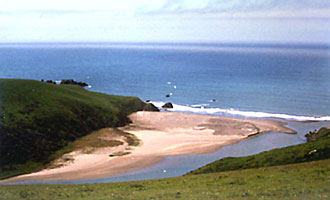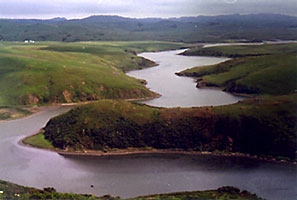
(Courtesy of Gulf of the Farallones National Marine Sanctuary)

|
The Esteros Americano and de San Antonio are coastal estuaries located on Bodega Bay, north of San Francisco, California. The open waters of Estero Americano covers approximately 400 acres and the wetlands is an additional 400 acres. Estero Americano varies in width from less than a meter (3 feet) to 365 meters (1200 feet) and it has a constant shallow depth of 2 to 4 meters (6 to 13 feet). The Estero de San Antonio is a smaller estuary, it includes 90 acres of open water and approximately 200 acres of wetland habitats. The average depth of the Estero de San Antonio is approximately 6 meters (20 feet) and its width varies from 6 meters to 60 meters (20-200 feet). The two estuaries are separated by 12 square miles of coastal hills. The salinities of each of the estuaries varies depending on marine tides. Hypersaline conditions can occur within the estuaries when sand bar formation closes the estuary's mouth and the freshwater flows diminish. In the Estero Americano salinities of 67 parts per thousand was measured in later August. This sand bar formation in the estuaries is due to prevailing northwest winds and currents that carry sediment from the beaches.  (Courtesy of Gulf of the Farallones National Marine Sanctuary) There are many different habitat types that can be found in the estuarine systems including mudflats, marshes, rocky shore, coastal scrub and grasslands. With the variety of habitats, the Esteros are attractive and valuable to many species of wildlife. The Esteros Americano and de San Antonio provide essential feeding and resting areas for water birds. There are a total of 31 marine and freshwater fish species that have been identified in the estuaries; 14 species are common to both estuaries, 10 species have been identified only in the Estero de San Antonio and 7 species common to Estero Americano. The number of species of fish is greatest at the mouth of the estuaries. Some common species include, Pacific herring, staghorn sculpins, gobies, and starry flounder. There are also reptiles and amphibians that inhabit the marsh lands of the two estuaries. The western pond turtle is common in the freshwater ponds. There are also many invertebrates that inhabit the estuaries. |